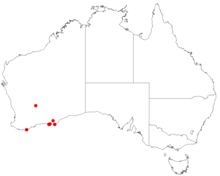Styphelia multiflora
| Styphelia multiflora | |
|---|---|
| Scientific classification | |
| Kingdom: | Plantae |
| Clade: | Tracheophytes |
| Clade: | Angiosperms |
| Clade: | Eudicots |
| Clade: | Asterids |
| Order: | Ericales |
| Family: | Ericaceae |
| Genus: | Styphelia |
| Species: | S. multiflora
|
| Binomial name | |
| Styphelia multiflora | |

| |
| Occurrence data from AVH | |
| Synonyms[1] | |
| |
Styphelia multiflora is a species of flowering plant in the family Ericaceae and is endemic to the southwest of Western Australia. It is a rigid shrub with crowded, sharply-pointed, linear to lance-shaped leaves, and white, tube-shaped flowers usually in groups in leaf axils.
Description[edit]
Styphelia multiflora is a stout, rigid shrub with sotly-hairy branches. Its leaves are crowded, linear to lance-shaped, concave, about 12 mm (0.47 in) long and sharply-pointed. The flowers are arranged in leaf axils in groups of 3, 4 or more on a short peduncle with bracts and bracteoles less than half as long as the sepals. The sepals are about 2 mm (0.079 in) long and narrow, the petals white and about 4 mm (0.16 in) long, forming a tube with lobes about as long as the petal tube.[2][3]
Taxonomy[edit]
This species was first formally described in 1810 by Robert Brown in his Prodromus Florae Novae Hollandiae et Insulae Van Diemen.[4][5] In 1824, Kurt Polycarp Joachim Sprengel transferred the species to Styphelia as S. multiflora in his Systema Vegetabilium.[1] The specific epithet (multiflora) means "many-flowered".[6]
Distribution[edit]
This styphelia occurs in the Esperance Plains bioregion of south-western Western Australia.[3]
Conservation status[edit]
Styphelia multiflora is listed as "Priority One" by the Government of Western Australia Department of Biodiversity, Conservation and Attractions,[3] meaning that it is known from only one or a few locations which are potentially at risk.[7]
References[edit]
- ^ a b c "Styphelia multiflora". Plants of the World Online. Retrieved 12 March 2024.
- ^ Bentham, George (1868). Flora Australiensis. Vol. 4. London: Lovell Reeve & Co. pp. 221–222. Retrieved 21 February 2023.
- ^ a b c "Styphelia multiflora". FloraBase. Western Australian Government Department of Biodiversity, Conservation and Attractions.
- ^ "Leucopogon multiflorus". APNI. Retrieved 21 February 2023.
- ^ Brown, Robert (1810). Prodromus Florae Novae Hollandiae et Insulae Van Diemen. London. p. 542. Retrieved 21 February 2023.
- ^ Sharr, Francis Aubi; George, Alex (2019). Western Australian Plant Names and Their Meanings (3rd ed.). Kardinya, WA: Four Gables Press. p. 256. ISBN 9780958034180.
- ^ "Conservation codes for Western Australian Flora and Fauna" (PDF). Government of Western Australia Department of Parks and Wildlife. Retrieved 21 February 2023.

